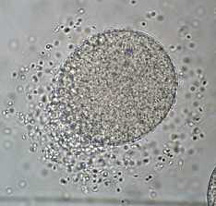|
|

|
Inhibition of
the fast and slow blocks to polyspermy
Objective:
to test the effects of inhibiting the fast and slow blocks
to polyspermy on sea urchin development.
|
Background
Sea urchin eggs release components of the egg
jelly that attract sperm and induce the acrosome
reaction (Gilbert, 2000). In the laboratory, a
single egg many be covered with dozens or even
hundreds of sperm burrowing through the egg
jelly.
|

Sperm in jelly coat surrounding L. pictus
egg
|
|
|
|
|
|
|
Once a sperm contacts the viltelline
membrane, it binds to a receptor protein that triggers the
events of fertilization. Eventually, the plasma membranes
fuse, and the sperm nucleus and centriole enter the egg.
However, if a single egg is fertilized by multiple sperm
(polyspermy), additional chromosomes and centrioles are
brought inside. This can cause defects at the first cleavage
division as the chromosomes are segregated randomly between
multiple spindles (Just, 1919, Gilbert, 2003).
Two mechanisms have evolved to reduce
the occurrence of polyspermy. Sperm binding initially
triggers an influx of Na+ ions leading to depolarization,
which transiently blocks binding of additional sperm (known
as the fast blockto
polyspermy). This depolarization can be blocked by the
addition of nicotine (Jaffe, 1980). In addition, sperm
binding also stimulates the release of Ca++ ions from the
endoplasmic reticulum, leading to the fusion of a series of
exocytic vesicles (the cortical granules) with the plasma
membrane. This releases their contents, including a
trypsin-like protease, which destroys the sperm binding
sites on the vitelline membrane and detaches it from the
plasma membrane (Vacquier, et al, 1973). Water rushes into
the space, causing the vitelline membrane to rise up and
become the fertilization envelope. This produces a more
permanent block to polyspermy (the slow block).
|
|
|
![]()
![]()
![]() 1 2
1 2 ![]()